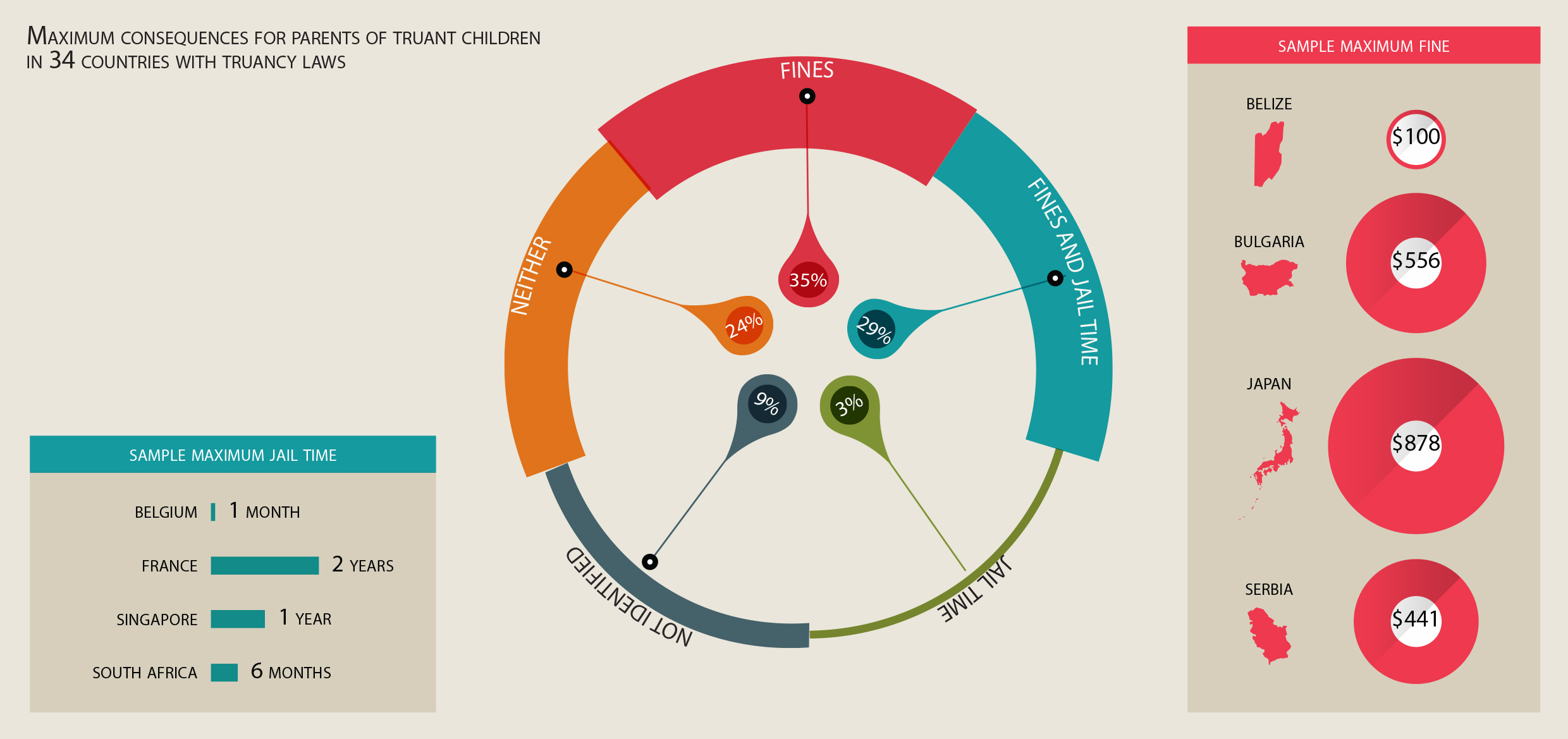Accountable parents and students
Key Messages
- Parents have the main responsibilities for their children’s attendance and behaviour in basic education. Students take on more of these responsibilities as they get older.
- In 34 countries with truancy laws, over one-third stipulated fines and almost one-third jail time for parents of truant juveniles. But no evidence suggested these reduced chronic absenteeism, and punitive measures imposed harsh burdens on poor families.
- Cash transfers conditional on attendance encourage poor families to meet their education responsibilities and, if well targeted, can help overcome barriers due to low finances or low parental education.
- Students have the right to feel safe and supported in their learning environments. Yet school violence is prevalent in many countries. School codes of conduct and parent-teacher contacts through meetings and training have been shown to reduce violence.
Accountability policies usually hold governments, schools and teachers responsible for the right to good-quality public education. But as education is a shared societal endeavour, parents and students also have important roles to play. Parents are responsible for providing a stimulating home environment but also for supporting their children’s school attendance, effort and behaviour. Students take on more of the latter responsibilities as they get older.
TRUANCY LAWS STIPULATE PENALTIES FOR PARENTS AND STUDENTS
Truancy – unauthorized absence from school – is a pervasive problem worldwide. On average, across 33 countries participating in the Global School-based Student Health Survey, one in three adolescents aged 13 to 17 reported being truant in the previous 30 days, varying from 20% in the Bahamas and Uruguay to over 40% in Kuwait, Oman and Tokelau. Truancy is associated with negative short- and long-term consequences for students; it is linked with grade retention and dropout, as well as involvement with the justice system.
Disadvantaged students are more likely to be truant. While truancy is a multidimensional phenomenon involving various factors, parents’ role in mitigating it is important. Many countries have truancy laws that hold parents accountable for attendance. Fines are the most common penalties, although a few countries apply criminal charges (Figure 7). Severe sanctions disproportionately affect low income families and women, who head most single-parent households.
Therefore, truancy laws, while providing a legal framework, need to be accompanied by a supporting structure for prevention. Improving parents’ accountability starts by understanding and improving the school parent relationship, as examples from Australia, France and Ireland suggest.
CONDITIONAL CASH TRANSFERS TARGET POOR FAMILIES
Conditional cash transfers (CCTs) provide poor families with subsidies conditional on parents ensuring that their children go to school. They were pioneered in Latin American countries, including Brazil, Colombia and Mexico, and expanded to middle and low income Asian and sub-Saharan African countries. In Europe and Northern America, CCTs generally apply negative incentives, which act like fines. Romania, for example, interrupts poor families’ child allowance after several unexplained absences.
CCTs have increased attendance, particularly of girls, in Bangladesh, Cambodia, Nicaragua and elsewhere. A review of CCT programmes in 34 high income countries found similar results. Their effectiveness depends on their targeting, the ease of access to school and the size of the transfer, which must be sufficient to cover opportunity costs of attendance.
Codes of conduct aiming to teach students acceptable interaction strategies have been shown to be effective in reducing school violence
PARENTS AND STUDENTS PLAY AN ESSENTIAL ROLE IN FOSTERING SAFE LEARNING ENVIRONMENTS
To learn, children and adolescents need to feel safe and supported in their learning environments. As active partners in creating this environment, students have a responsibility to ensure that their behaviour does not deny others the right to such safety and support.
Schools are increasingly using codes of conduct to teach students acceptable interaction strategies. Such codes have been shown to be effective in reducing school violence. While mostly found in Europe and Northern America, the approach has also been applied in Asian countries, such as Singapore.
In addition to clear and consistent rules and disciplinary standards for students, meetings and training for parents form an important component of reducing the incidence of school violence. Parents contribute to the development of their children’s peer relationships both directly (e.g. helping children develop peer relationship skills) and indirectly (e.g. through parent attitudes).
In the United States, home environments where parents unduly criticize their children, impose few rules, mistreat their children and are violent towards each other have been linked to greater incidence of bullying. In Egypt, Morocco and Tunisia, greater parental encouragement, emotional support and parent–child communication has been associated with a reduced likelihood of peer victimization.


